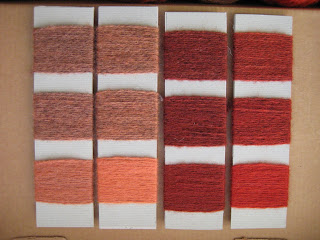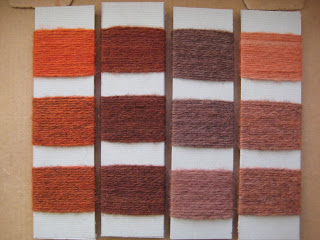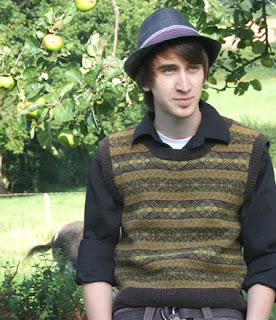It's hard work walking here - whatever direction you take from the village the first thing you have to do is go up a steep hill, but the reward is fantastic views, and on a clear day these stretch as far as the Cambrian Mountains and on into the start of Snowdonia.
I think - I'm lucky to live in a place like this. But then, actually, it's the result of years of hard work and no holidays. But then - living here, why would you want to go away?
Wednesday 27 October 2010
Sunday 17 October 2010
Country Living magazine
November's issue of Country Living magazine has a feature on wool to coincide with the Campaign for Wool. Turning the pages I was surprised to see a photo of the tea- and egg-cosies I make for Damson and Slate in Narberth! Damson and Slate is a small shop selling a range of knitted and woven and felted woolly lovelies, several of which are in the feature. Do look out for it.
http://www.campaignforwool.org/
http://www.damsonandslate.co.uk/
http://www.campaignforwool.org/
http://www.damsonandslate.co.uk/
Friday 15 October 2010
Colours with Madder
A year ago now I did some experimenting with Madder, and so it's about time I posted something about it! I was interested to see what effect different water qualities would have. Whenever we are at a show, we get comments about the lovely bright reds we get - commonly people seem to get 'tomato soup orange'. My dyeing 'bibles' are three old books: and one thing shines through in these - water quality. The old dye-houses were in areas where water produced the best results. Madder does best in hard water, but Talgarth is in a valley of old red sandstone (not that I'm a geologist or anything - that's what is always mentioned when local agents are selling a farm....).
Using Madder extract at 10% weight of goods, I dyed samples on various shades of Shetland wool, using water from three sources, using observations around the water source as a guide to the sort of quality to expect:
1. Our spring at Pontithel, just along the road from Talgarth. This used to feed a pond for the Victorian lime kilns and charcoal ovens, now demolished to foundations, and for years was left to run through a pipe in the wall from where it drained through the ground and down to a stream. The end of the pipe had a great limey crust, so I wondered if this meant the water would produce even better reds.
2. The water running from an underground pipe at our mill near Newquay, Ceredigion. The deposits accumulating around this pipe are very rust coloured, and the soil is on the acid side of neutral. The stone in the buildings often has rust-red colouring, and wherever water runs (and being an old water-mill there's quite a lot!) it leaves orange stains.
3. Tap water from Talgarth. This is what we usually use, and what I would use for a 'cold' dyeing and dyeing at different temperatures.
The wool was all mordanted with Alum at 8% and Cream of Tartar at 7% (Cream of Tartar can also affect Madder, some people prefer not to use it)
Pontithel: the slightly darker/duller sets have had iron added towards the end of dyeing. the photo doesn't do the colour justice - the reds are very full and a beautiful colour. This means that I am going to have to have large conatiners to fill from the spring every time I want to dye with Madder...
Felin: You can see the difference though, especially in the lighter red in this set of samples (below). Adding iron made the wool a little harsh - probably because of iron already present in the water. On fawn and grey yarns, the Madder produced some lovely terracottas. So - now there's 24 shades!
Different temperatures also affect Madder. The best reds are gained by controlling the temperature at 60%. For this set, I used a precision temperature controller and dyed each of the yarn samples at the temperature indicated for 45 minutes, adding iron as before to get the darker colours. Another 6 shades!
Finally, how much colour can you get just by soaking at room temperature? This last set were left at intervals as on the cards. The dye pot was stirred up daily and left in the dark. I wound some of the yarn afterwards onto a second set of cards and left them in the west facing window. I was pleasantly surprised to find little difference in intensity of colour after 2 months. I really must do some simple washing tests though as well.
This test was interesting - Madder takes time and patience to get a really good colour, lots of attention and slow raisin of temperature. Leaving it cold to it's own devices gave an even colour and left me time to do other things!
My old books have several other recipes and notes for madder, so I'm not quite done yet.....
Using Madder extract at 10% weight of goods, I dyed samples on various shades of Shetland wool, using water from three sources, using observations around the water source as a guide to the sort of quality to expect:
1. Our spring at Pontithel, just along the road from Talgarth. This used to feed a pond for the Victorian lime kilns and charcoal ovens, now demolished to foundations, and for years was left to run through a pipe in the wall from where it drained through the ground and down to a stream. The end of the pipe had a great limey crust, so I wondered if this meant the water would produce even better reds.
2. The water running from an underground pipe at our mill near Newquay, Ceredigion. The deposits accumulating around this pipe are very rust coloured, and the soil is on the acid side of neutral. The stone in the buildings often has rust-red colouring, and wherever water runs (and being an old water-mill there's quite a lot!) it leaves orange stains.
3. Tap water from Talgarth. This is what we usually use, and what I would use for a 'cold' dyeing and dyeing at different temperatures.
The wool was all mordanted with Alum at 8% and Cream of Tartar at 7% (Cream of Tartar can also affect Madder, some people prefer not to use it)
Pontithel: the slightly darker/duller sets have had iron added towards the end of dyeing. the photo doesn't do the colour justice - the reds are very full and a beautiful colour. This means that I am going to have to have large conatiners to fill from the spring every time I want to dye with Madder...
Felin: You can see the difference though, especially in the lighter red in this set of samples (below). Adding iron made the wool a little harsh - probably because of iron already present in the water. On fawn and grey yarns, the Madder produced some lovely terracottas. So - now there's 24 shades!
Different temperatures also affect Madder. The best reds are gained by controlling the temperature at 60%. For this set, I used a precision temperature controller and dyed each of the yarn samples at the temperature indicated for 45 minutes, adding iron as before to get the darker colours. Another 6 shades!
Finally, how much colour can you get just by soaking at room temperature? This last set were left at intervals as on the cards. The dye pot was stirred up daily and left in the dark. I wound some of the yarn afterwards onto a second set of cards and left them in the west facing window. I was pleasantly surprised to find little difference in intensity of colour after 2 months. I really must do some simple washing tests though as well.
This test was interesting - Madder takes time and patience to get a really good colour, lots of attention and slow raisin of temperature. Leaving it cold to it's own devices gave an even colour and left me time to do other things!
My old books have several other recipes and notes for madder, so I'm not quite done yet.....
Monday 4 October 2010
Dilemmas on using Colour
It had been on my mind that I needed to order more cochineal. It's a very economical dye to use, although expensive to buy in the first instance; after obtaining deep red or magenta colours, the same dye-bath will give deep pink on a second batch of wool, then paler pink and, with luck, a fourth shade. The shades obtained, including all varieties of purple and lilacs when a touch of iron is added, are among the most popular we do.
Imagine, then, my dismay to find that our dye supplier has not only sold out, but there appears to be a world-wide shortage that won't be rectified until next year's harvest. And then I discovered that cochineal may be put on a 'red list' by GOTS (Global Organic Textile Standards organisation) and may be disallowed as a dye because of it's environmental impact, although need to find out more about this.
It raises all sorts of questions again about the whole sustainable / organic / ethical etc etc movements. Not just textiles, but anything that needs to use colour to sell a product.
As humans, we are addicted to colour - there's not much that we use that doesn't have colour added. And it has to come from somewhere. But whether it's from 'natural' sources or the laboratory, as consumers we think little of it's application. All dyeing is a chemical process and involves additional chemical input if the end product is to meet with modern requirements and expectations.
Maybe it's time to put much more value on colour? When planning our collection, we try to use an equal amount of dyed colours to natural shades, at least with the knits. I think it makes the colours stand out more and reduces our use of dyes and mordants. It's not so easy with fabrics. Knits are created from scratch by us, from undyed yarns. Fabrics are dyed 'in the piece' or woven in a larger quantity from already dyed yarns - one day we may be big enough to commission our own fabrics! In the meantime, we have to choose from the best options available.
Just because something is 'environmentally friendly' or 'sustainable', it doesn't mean we can carry on using it at will. What we really need is better quality, longer lasting items that make good use of limited resources, and to vastly reduce our have it all, throw away culture. But where would that leave our economies? Is there an answer or have we gone just too far?
Imagine, then, my dismay to find that our dye supplier has not only sold out, but there appears to be a world-wide shortage that won't be rectified until next year's harvest. And then I discovered that cochineal may be put on a 'red list' by GOTS (Global Organic Textile Standards organisation) and may be disallowed as a dye because of it's environmental impact, although need to find out more about this.
It raises all sorts of questions again about the whole sustainable / organic / ethical etc etc movements. Not just textiles, but anything that needs to use colour to sell a product.
As humans, we are addicted to colour - there's not much that we use that doesn't have colour added. And it has to come from somewhere. But whether it's from 'natural' sources or the laboratory, as consumers we think little of it's application. All dyeing is a chemical process and involves additional chemical input if the end product is to meet with modern requirements and expectations.
Maybe it's time to put much more value on colour? When planning our collection, we try to use an equal amount of dyed colours to natural shades, at least with the knits. I think it makes the colours stand out more and reduces our use of dyes and mordants. It's not so easy with fabrics. Knits are created from scratch by us, from undyed yarns. Fabrics are dyed 'in the piece' or woven in a larger quantity from already dyed yarns - one day we may be big enough to commission our own fabrics! In the meantime, we have to choose from the best options available.
Just because something is 'environmentally friendly' or 'sustainable', it doesn't mean we can carry on using it at will. What we really need is better quality, longer lasting items that make good use of limited resources, and to vastly reduce our have it all, throw away culture. But where would that leave our economies? Is there an answer or have we gone just too far?
Friday 1 October 2010
Autumn Knits
Oliver agreed to do some modeling for us - makes a real change to have a male model!
Here's our Pwll y Wrach pullover - in English this means 'Witch's Pool'. The water tumbles down from the Black Mountains above Talgarth, falling into a pool at the top of the woods before rushing on down through the trees in the valley. The whole of the wooded valley is a nature reserve - home to dormice, rare plants and much beauty.
As the sun shines through it creates splashes of brightness and dappled shade, reflected in the colour sequences in the patterning on the front of this pullover. The greens and yellowy golds come from weld, coreopsis, oak, and goldenrod.
Here's our Pwll y Wrach pullover - in English this means 'Witch's Pool'. The water tumbles down from the Black Mountains above Talgarth, falling into a pool at the top of the woods before rushing on down through the trees in the valley. The whole of the wooded valley is a nature reserve - home to dormice, rare plants and much beauty.
As the sun shines through it creates splashes of brightness and dappled shade, reflected in the colour sequences in the patterning on the front of this pullover. The greens and yellowy golds come from weld, coreopsis, oak, and goldenrod.
Subscribe to:
Posts (Atom)






